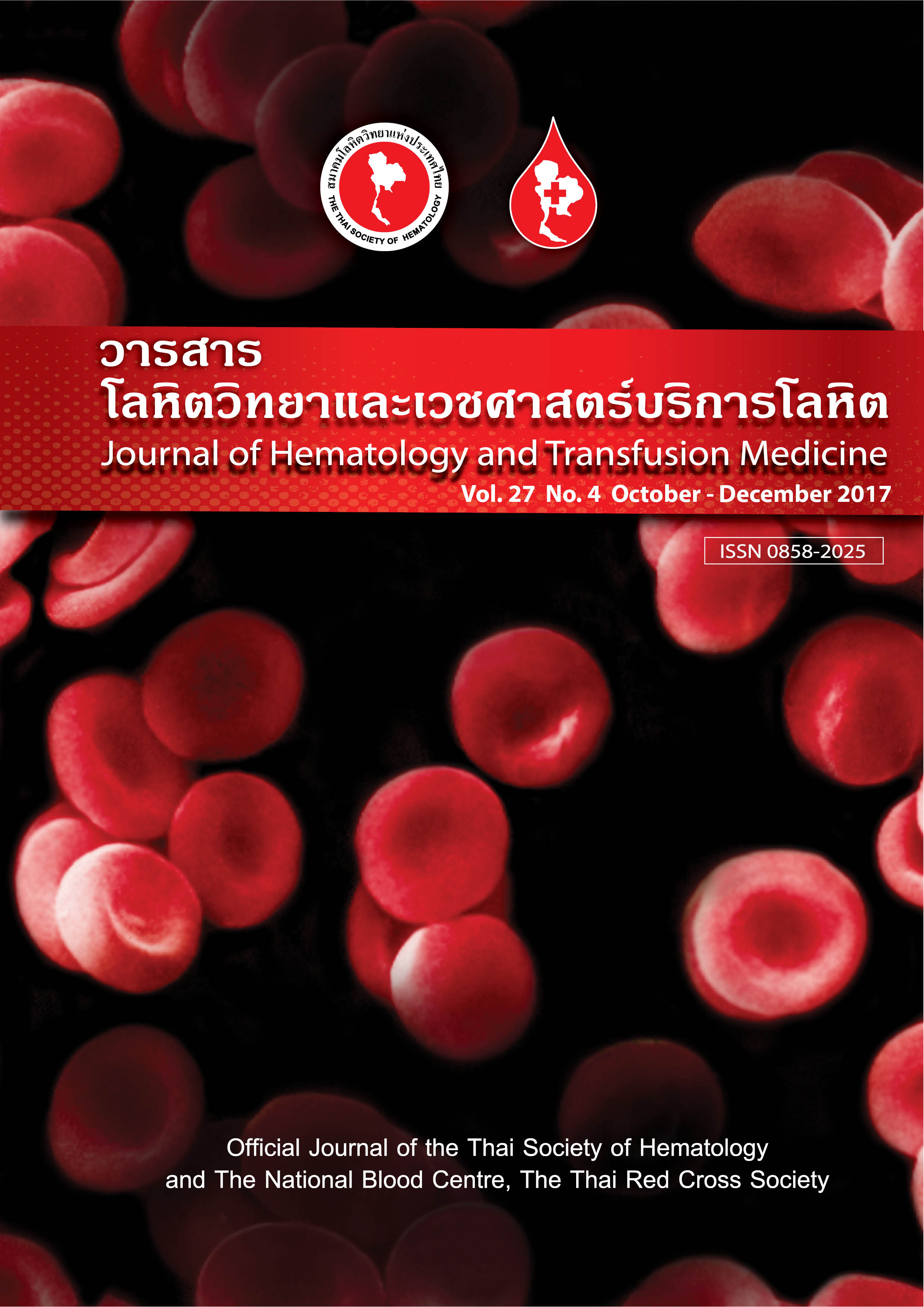ความคงทนของแอนติเจนหมู่เลือดในผลิตภัณฑ์ Identification Panel Cells ผลิตโดยศูนย์บริการโลหิตแห่งชาติ สภากาชาดไทย
Keywords:
Identification panel cells stability, Identification panel cells reagent, Antigen potencyAbstract
บทคัดย่อ
เนื่องจาก identification panel cells มีความสำคัญในการตรวจเพื่อบอกชนิดของแอนติบอดีในผู้ป่วยและผู้บริจาคโลหิต คุณภาพจึงเป็นสิ่งสำคัญที่ผู้เตรียมต้องตระหนักเพื่อความปลอดภัยของผู้ป่วยที่มีแอนติบอดีและมีความจำเป็นต้องได้รับเลือด วัตถุประสงค์ เพื่อประเมินความคงทนของแอนติเจนหมู่เลือดในผลิตภัณฑ์ identification panel cells ที่ผลิตโดยศูนย์บริการโลหิตแห่งชาติ สภากาชาดไทย วัสดุและวิธีการ นำผลิตภัณฑ์ identification panel cells จำนวน 3 ชุดของการผลิตได้แก่ Lot.No. 58010, 58020 และ 58030 มาทดสอบความแรงของแอนติเจนกับแอนติบอดีที่จำเพาะ โดยเจือจางแบบ serial two-fold dilution จากนั้นทดสอบด้วยวิธี conventional tube test (CTT) และวิธี column agglutination technique (CAT) โดยใช้ ID LISS/Coombs Card และ ID NaCl, Enzyme Card ของบริษัท Bio-Rad ประเทศสวิสเซอร์แลนด์ อ่านผลปฏิกิริยาเป็นคะแนน (score) คำนวณหาร้อยละของความแรงของแต่ละแอนติเจนที่ลดลงระหว่างวันแรกที่ผลิตเสร็จ (สัปดาห์ที่ 0) สัปดาห์ที่ 4 และเมื่อเก็บต่อถึงสัปดาห์ที่ 10 ผลการศึกษา identification panel cells เมื่อผลิตเสร็จและถูกนำมาทดสอบความแรงของแอนติเจนทุกๆสองสัปดาห์ พบว่าเมื่อครบ 4 สัปดาห์มีความแรงของแอนติเจนลดลงจำแนกได้เป็น 4 กลุ่มได้แก่ กลุ่มที่ 1 มีความแรงของแอนติเจนลดลงร้อยละ 0-5 ได้แก่ แอนติเจน c, M, S, s, Lea, Jka, Fya, k และ Dib กลุ่มที่ 2 มีความแรงของแอนติเจนลดลงร้อยละ 6-10 ได้แก่ แอนติเจน D, C, E, e, N, Jkb และ K กลุ่มที่ 3 มีความแรงของแอนติเจนลดลงร้อยละ 10-20 ได้แก่ แอนติเจน P1, Leb และ Dia และกลุ่มที่ 4 มีความแรงของแอนติเจนลดลงมากกว่าร้อยละ 20 ได้แก่ แอนติเจน Mia และ Fyb เมื่อเก็บ identification panel cells ต่อถึงสัปดาห์ที่ 10 พบว่าแอนติเจนมีผลความแรงลดลงตามระยะเวลา และแอนติเจนที่มีความแรงลดลงมากที่สุด คือ Mia (ร้อยละ 52.78) รองลงมา คือ K, Dia และ Fyb ซึ่งอยู่ในกลุ่มที่ 2 , 3 และ 4 มีความแรงลดลงคิดเป็นร้อยละ 47.46, 46.00 และ 41.88 ตามลำดับ สรุป จากการศึกษาแสดงว่า identification panel cells ที่มีอายุมากกว่า 1 เดือน ยังคงมีความแรงของแอนติเจนสูงสามารถนำไปใช้ตรวจยืนยันชนิดของแอนติบอดีและตรวจแยกชนิดของ multiple antibodies ได้ โดยเฉพาะอย่างยิ่ง rare antigen ซึ่งหาได้ยากในคนไทย เช่น K(+) และ Fy(a-) เป็นต้น ทั้งนี้เพื่อให้ผู้ป่วยได้รับเลือดที่เหมาะสมและปลอดภัย
Abstract
Identification panel cells are used to identify alloantibodies of the patients and blood donors. The quality of panel cells are essential that the producer should be considered in order to provide appropriated blood for alloimmunized patients. Objective This study aims to evaluate the stability of red blood cell antigens in identification panel cells prepared by the National Blood Centre, Thai Red Cross Society. Materials and Methods The serial two-fold dilution of three sets of identification panel cells (Lot. No.58010, 58020, and 58030) were tested with conventional tube test (CTT) andcolumn agglutination technique (CAT) using ID LISS/Coombs Card and ID NaCl, Enzyme Card of Bio-Rad company. The antigen potency was determined by score and calculated the percentage decrease of potency at week 0 (the first day of reagent preparation), week 4 (the expired date) and week 10. Results The results obtained were separated into four groups of the antigen decreasing score percentages (0-5%, 6-10%, 10-20% and >20%, respectively). The first group, 0-5% decreasing scores were found in c, M, S, s, Lea, Jka, Fya, k and Dib antigens. The second group, 6-10% decreasing scores were found in D, C, E, e, N, Jkb and K antigens. The third group, 10-20% were found in P1, Leb,Dia antigens and the fourth group, >20% were found in Fyb and Mia antigens. In addition, we also tested the antigen potency after 10 weeks and found that Mia antigen had the most decrease score (52.78%), followed by K, Dia and Fyb antigens (47.46%, 46.00% and 41.88%, respectively). Conclusion The study indicates that even after 4 weeks, theidentification panel cells still have high antigen potency. These cells are suitable for confirmation and identification of mixture of antibodies especially panel cells with rare antigen such as K(+) and Fy(a-). Thus, appropriate blood could be transfused to the patients.



